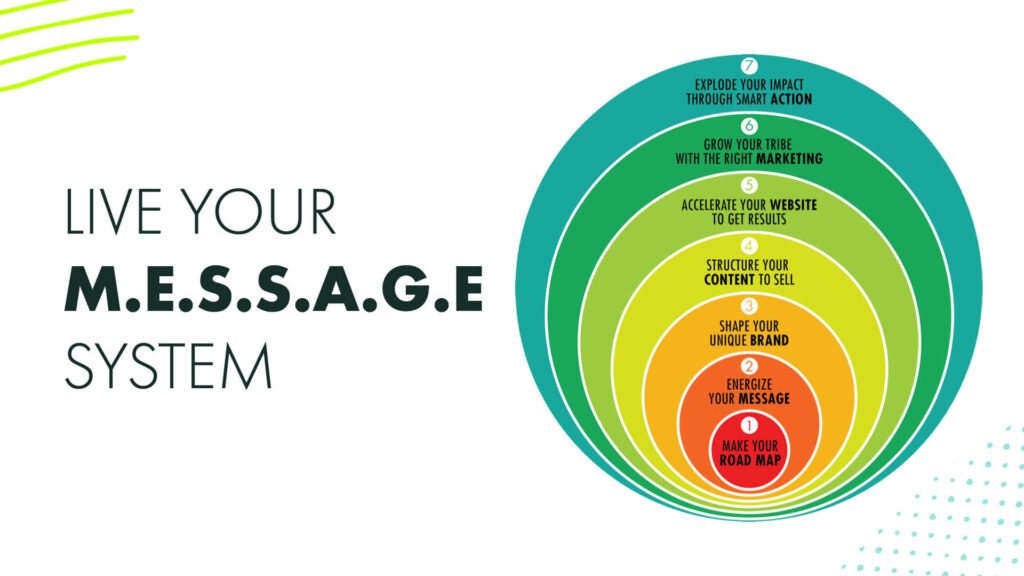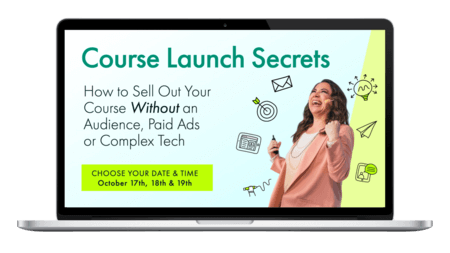If you’ve been anywhere on the internet in the last year and a half, you’ve probably seen ads promising to teach you how to build a course using AI. Sounds pretty simple, right?
Just plug in your ideas, let the AI do its magic, and voila! You’ve got a course.
But here’s the thing: while AI can be an amazing tool, there’s a huge difference between creating a course that merely exists and one that actually delivers results — for you AND your students.
So, should you create an AI-based course?
The answer is a resounding NO if you want a course that truly stands out, creates real transformations and drives long-term success.
And in this post, I’m going to share exactly why relying solely on AI to create your online course is a recipe for disaster in 2024. More importantly, I’ll reveal the ONE thing AI can’t do that’s absolutely essential to your success as a course creator.
Why AI IS So Tempting
When ChatGPT was released in December 2022, it took the world by storm. Suddenly, AI-based tools and AI-generated content were everywhere, promising to make life easier, boost productivity, and, yes, even create entire online courses for you.

The possibilities seemed endless: AI could brainstorm ideas, generate content, automate tedious tasks and even help with marketing. For many, it felt like the ultimate shortcut to building a profitable course without the headaches.
But here’s the cold, hard truth: AI might be great at generating information, but information alone isn’t enough to create a successful online course. In fact, it’s often the very thing that leads to failure.
The Danger of Information Overload
Let’s talk about what I like to call the “thud” factor. It’s the idea that the more content you deliver, the bigger the perceived value. You know, that satisfying “thud” when a heavy package of information lands on your doorstep — or in today’s world, your inbox.

This myth has been around for ages, from door-to-door Encyclopedia Britannica salesmen to the early days of information marketing. The more you cram into a course, the more valuable it must be, right?
Wrong.
In reality, this approach leads to information overload. It’s like trying to drink from a fire hose — overwhelming, exhausting and ultimately ineffective. And that’s exactly what’s happening with many AI-generated courses today.
When students are bombarded with endless modules, lessons and resources, they don’t get value. They get overwhelmed. They get frustrated. And more often than not, they give up.
Why Information Alone ISN’T Enough
Let’s face it: if information alone could solve all our problems, we’d all be living in Googletopia — or ChatGPTopia — by now. We’d be rich, happy, healthy and thriving because we’d have all the answers at our fingertips, 24/7.

But we’re not.
Because information doesn’t lead to action. And without action, nothing changes.
This is the biggest mistake I see course creators making — they think that packing their course with as much information as possible will guarantee success. But in reality, it’s a recipe for refunds, low completion rates and declining sales.
My Hard-Learned Lesson in Course Creation
Back in 2012, I launched my first big course, Message to Money, featuring my Live Your M.E.S.S.A.G.E. System. It was packed with content — six courses in one, all crammed into a single six-week program.

I spent months creating the content, building the sales page, writing the emails and putting everything together. And while I made some sales and felt like I was on my way, the cracks quickly started to show.
Refund rates were high, and when I dug deeper, I discovered that only around 5% of my students were actually completing the course. The rest? Overwhelmed, frustrated and dropping out.
It was a hard pill to swallow, but it taught me a valuable lesson: more information isn’t the answer. What matters is how you engage your students and get them to take action.
The Real Secret to Course Success: Experiential Learning
So, if AI-generated information isn’t the answer, what is?
It’s all about creating an experience — what I like to call an “Experience Product” rather than an “Info Product.” This is the secret sauce that gets your students into action, keeps them engaged and drives real results.

An Experience Product is designed to create specific kinds of experiences that inspire your students to take consistent action. It’s about moving them from information overload to actual transformation.
Here are four critical experiences you need to embed in your course to make it truly effective:
- Shared Experiences: People crave connection and community. Build an engaged community where students can support and learn from each other, whether through group coaching calls, virtual events or online forums.
- Perceived Customization: Your students want to feel like your course is tailored just for them. This doesn’t mean you need to create a personalized course for each student, but rather design your course so it feels like a unique experience for everyone.
- Constant Wins: Create a game-like experience where your students can achieve small, easy wins that build their confidence and keep them motivated. Instead of saving the rewards for the end, offer micro-rewards throughout the course.
- Emotional Experiences: Engage your students on an emotional level. Use storytelling, multisensory language and pattern interrupts to keep them invested and excited about their progress.
Real-World Examples of Experiential Learning in Action
To truly grasp the power of experiential learning, let’s look at some compelling real-world examples that showcase how creating unique experiences can lead to massive engagement and success.
Fitbit: Fitbit isn’t just a fitness tracker — it’s a personal coach, motivator and accountability partner all rolled into one. This wearable tech transforms daily steps and heart rate monitoring into a dynamic, personalized experience.
Every time you meet a goal or reach a milestone, Fitbit responds with celebrations and encouragement, making it feel like you have a coach cheering you on every step of the way. This personalization keeps users engaged and motivated, turning a simple product into a transformative experience.
Spotify: Spotify revolutionized the music industry by turning the act of listening to music into a shared, social experience. Through features like collaborative playlists, real-time listening sessions and personalized song recommendations, Spotify turned music from a solitary activity into a community-driven experience.
Users don’t just listen to music; they share it, discover it together and bond over their favorite tunes. This shared experience has been key to Spotify’s success, driving user engagement and loyalty.
Taylor Swift’s Eras Tour: Taylor Swift’s Eras Tour is a masterclass in creating unforgettable, experiential events. Understanding that her largely Gen Z audience craves participation and social connection, Swift designed a tour that was much more than just a series of concerts.

(Taylor Swift in Detroit on June 9.Scott Legato / Getty Images for TAS Rights Management)
Each show became an immersive experience, complete with themed costumes, fan participation and exclusive moments that felt tailored just for the attendees. Fans weren’t just passive spectators; they were active participants in a once-in-a-lifetime event.
The result?
Swift’s tour became a cultural phenomenon, dominating social media and selling out venues worldwide. This level of engagement and emotional connection is something NO AI-generated experience could replicate.
Experience Product Masterclass (EPM): Now, let’s talk about something close to home — my signature program — the Experience Product Masterclass (EPM). EPM is designed around the principles of experiential learning. When Davina and Galen Detrick first joined EPM, they were ready to create a traditional info product for dentists. But after diving into EPM, they realized the future was in creating experiences, not just delivering information. They transformed their approach, building an experiential course that took their students on a journey rather than just providing content.
The result?
They didn’t just create one successful course; they built an online course empire with 12 courses and counting. Davina even retired from practicing dentistry to focus on their thriving online business, proving that experiential learning doesn’t just benefit students — it can transform the lives of course creators, too.
Why AI Alone Can’t Create These Experiences
While AI is fantastic for generating ideas, automating tasks and even helping with content creation, it can’t create the kind of personalized, engaging experiences that lead to real transformation.
Why?
Because experiences are human. They require empathy, understanding and a deep connection with your students. AI can’t replace the human touch that’s essential for building trust, motivating action and creating lasting change.
AI can assist in the process, but it shouldn’t be the sole creator of your course. It’s your job to design the experiences that will get your students results — AI is just a tool to help you do that more efficiently.
Looking Ahead: The Future of Online Courses in 2024
As we move into 2025, the landscape of online courses will continue to evolve. AI will play a bigger role in course creation, marketing and delivery, but the fundamental principles of what makes a course successful won’t change.
The courses that will stand the test of time are those that go beyond just delivering information. They’ll be the ones that create transformative experiences for their students — experiences that inspire action, foster connection and drive real results.

So, as you plan your next course, remember this: AI can be a powerful ally, but it’s not a replacement for the human experience. Focus on creating an Experience Product that gets your students into action, and you’ll set yourself up for success in 2024 and beyond!
Before you go…
Get Instant Access to my FREE Dopamine Button Guide!
Inside, you’ll discover 3 little-known brain hacks that skyrocket your course engagement & sales…
Here’s the thing: the “old way” of designing and launching courses just isn’t cutting it anymore.
If you want to attract students who buy and keep buying (not to mention send referrals your way!)…
You need to do things differently.
Enter the Dopamine Button — the super-secret button in your students’ brains that you can leverage to create incredible results for them AND repeat sales for you.
Love it? Hate it? Let me know...
-
Great post Marisa. We’ll be learning how to leverage AI to multiply our creative time for years to come. Maybe that’s a good course idea;)
-
Oh, definitely intriguing! Thank you for reading and for the love… Marisa and the team appreciate it so much 🙂
-
-
Great sharing
-
Thank you, Alison! Marisa appreciates it so, so much 🙂
-




























Leave a Comment